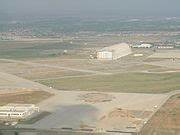
In the aftermath of a fire that engulfed a historic World War II blimp hangar in Southern California, the U.S. Navy faces an escalating bill, with cleanup costs potentially surpassing $137 million.

This incident at the Marine Corps Air Station Tustin, which occurred on November 7th, highlights the financial and cultural impact of maintaining and repurposing military infrastructure.

Constructed in 1942 by the Navy, the sites are still under their ownership.By the conclusion of World War II, the hangars had become outdated.

However, they continued to stand as enduring landmarks amidst the evolving landscape, as the population of Orange County surged from 200,000 in 1950 to 2.8 million by 2000.

The Navy transferred 1,300 acres of the 1,600-acre Tustin base to local government for various civic purposes, including parks, schools, homes, and businesses.

However, the Navy retained ownership of the oldest section of the base, which encompassed the two 17-story blimp hangars.

Thesears held historical significance and were listed on the National Register of Historic Places, prompting the Navy to maintain involvement in determining their future use.

Several proposals were considered over time, including plans for museums, a waterpark, and repair facilities for a new generation of lighterships, but none came to fruition.

Shortly after the fire, the U.S. Environmental Protection Agency determined that the Navy was accountable for the destruction caused by the fire and the release of toxic emissions.

The primary factor was that the North Hangar, which was destroyed in the fire, was one of two World War II-era anti-submarine blimp hangars constructed using 1 million board feet of Douglas fir.

These structures were a unique remnant of a time when the military maintained multiple bases across Southern California in the aftermath of the Japanese attack on Pearl Harbor.

The Navy’s initial commitment of $1 million for cleanup has been amended multiple times in the months following the fire, with the local government of Tustin shouldering a hefty financial burden—up to $90 million thus far.

The significant gap between costs and reimbursements from the Navy threatens Tustin’s ability to finance essential services like police and fire departments.

With California’s substantial budget deficit, state aid has been ruled out by Governor Gavin Newsom, leaving the Navy and local government to resolve the issue.

The Navy is working on removing debris and dismantling the hangar’s remnants, with fieldwork expected to start in the summer. Meanwhile, the site remains a poignant symbol of the region’s military history and a pressing concern for nearly 90,000 veterans residing in Orange County.
Relevant articles:
– Navy cost for fire at shuttered California blimp hangar could surpass $100M, Stars and Stripes
– cost space access: Topics by Science.gov, Science.gov
